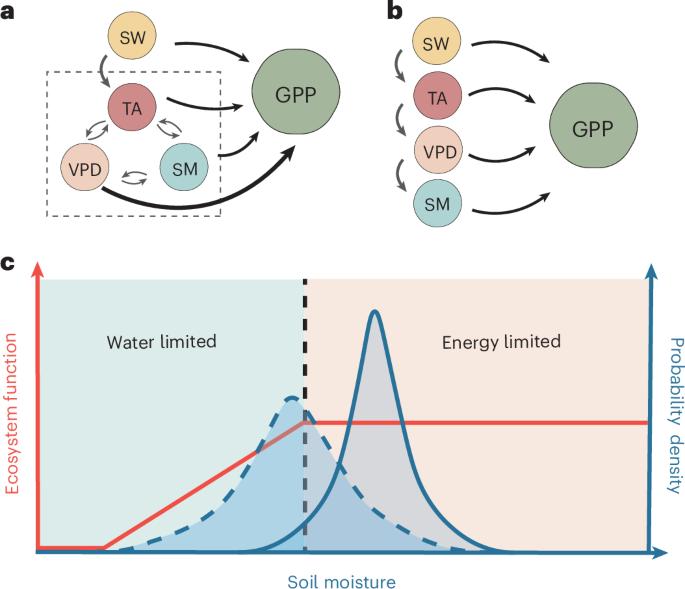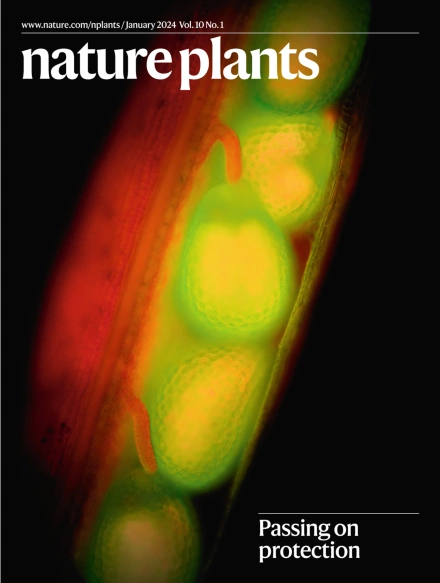When and where soil dryness matters to ecosystem photosynthesis
IF 13.6
1区 生物学
Q1 PLANT SCIENCES
引用次数: 0
Abstract
Projected increases in the intensity and frequency of droughts in the twenty-first century are expected to cause a substantial negative impact on terrestrial gross primary productivity (GPP). Yet, the relative role of soil water supply (indicated by soil moisture) and atmospheric water demand (indicated by vapour pressure deficit, VPD) on GPP remains debated, primarily due to their strong covariations, the presence of confounding factors and unresolved causal relationships among the interconnected hydrometeorological drivers of GPP. Here using a causality-guided explainable artificial intelligence framework, we show that soil moisture is the dominant regulator of water stress, surpassing the role of VPD, when and where soil water supply limits ecosystem functions. Temporally, we use in situ flux tower data to demonstrate that soil moisture dominates the GPP response during periods of insufficient soil water supply. Spatially, we assess the global spatial patterns of satellite sun-induced chlorophyll fluorescence (a proxy for GPP) in water-limited regions and demonstrate that they are mostly dominated by soil moisture. Conversely, VPD plays a greater role in controlling the temporal and spatial variations in GPP than soil moisture when and where soil water supply is not limited. The relative role of soil moisture and VPD is modulated by plant adaptation to long-term climatological aridity. Our findings advance the understanding of the impacts of soil and atmospheric dryness on ecosystem photosynthesis. They provide crucial insights into how terrestrial ecosystems respond to increasing aridity and more frequent droughts, particularly given the potential ecosystem shifts from energy to water limitation. Using a causality-guided explainable AI framework, Liu et al. show soil moisture dominates vapour pressure deficit in shaping global photosynthesis during water-limited conditions.


何时何地土壤干燥对生态系统光合作用有影响
预计21世纪干旱的强度和频率将增加,这将对陆地总初级生产力(GPP)造成重大的负面影响。然而,土壤水分供应(由土壤湿度表示)和大气水分需求(由蒸汽压差(VPD)表示)对GPP的相对作用仍存在争议,主要是由于它们的强协变、混杂因素的存在以及GPP相互关联的水文气象驱动因素之间未解决的因果关系。在这里,我们使用因果关系引导的可解释的人工智能框架,我们表明土壤湿度是水分胁迫的主要调节因子,超越了VPD的作用,当土壤供水限制生态系统功能时。在时间上,我们使用原位通量塔数据来证明土壤水分在土壤供水不足期间主导GPP响应。在空间上,我们评估了水资源限制地区卫星太阳诱导的叶绿素荧光(GPP的代理)的全球空间格局,并证明它们主要由土壤湿度主导。反之,在土壤水量不受限制的情况下,VPD对GPP时空变化的控制作用大于土壤湿度。土壤水分和VPD的相对作用是通过植物对长期气候干旱的适应来调节的。我们的发现促进了对土壤和大气干燥对生态系统光合作用影响的理解。它们为陆地生态系统如何应对日益严重的干旱和更频繁的干旱提供了至关重要的见解,特别是考虑到生态系统可能从能源限制转向水资源限制。
本文章由计算机程序翻译,如有差异,请以英文原文为准。
求助全文
约1分钟内获得全文
求助全文
来源期刊

Nature Plants
PLANT SCIENCES-
CiteScore
25.30
自引率
2.20%
发文量
196
期刊介绍:
Nature Plants is an online-only, monthly journal publishing the best research on plants — from their evolution, development, metabolism and environmental interactions to their societal significance.
 求助内容:
求助内容: 应助结果提醒方式:
应助结果提醒方式:


